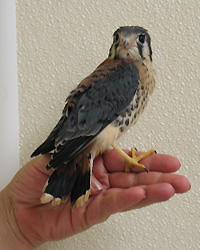
What do I do if I have found a Baby Bird...
IMPORTANT: Never attempt to feed or give water to orphaned or injured
wildlife.
-
...that has fallen from its nest?
If a baby bird has its eyes closed, has no or few feathers, and is unable
to stand or grip with its feet, then it is a hatchling or nestling and
still belongs in the nest. If the baby appears uninjured, every attempt
should be made to return the bird to its nest. Contrary to popular belief,
birds will continue to care for their young even after being handled by
humans. If the hatchling/nestling is cold, it should be warmed up with a
heating pad or other heat source before being returned to the nest. Watch
the nest from a distance, and if the parents do not return within two
hours or by dusk, then contact a wildlife rehabilitator.
Fresh feces around the baby and the nest indicate that the baby is being
fed by the parents. Baby birds only defecate when they are fed. Even if
you do not witness the parent feeding the baby, if you see fresh feces it
means the baby is being tended to and can be left alone.
-
...whose nest has fallen down?
If the nest is still relatively intact, place it into a shallow container
like a berry basket or tupperware. The container must have holes in the
bottom for drainage. If possible, mount the nest in its original location,
using string or wire to attach it securely to a sturdy branch. Otherwise,
select a location as close as possible that is protected from direct
sunlight, wind, rain, pets, and children. Watch the nest from a distance,
and if the parents do not return within two hours or by dusk, then contact
a wildlife rehabilitator.
-
...whose nest has been destroyed?
If the bird seems otherwise normal, hopping around and alert, it is
probably a fledgling just leaving the nest. Fledglings are feathered, and
may appear to be adults, but usually can be distinguished by their shorter
tails and fluffier bodies. If the bird is in imminent danger (e.g. on the
road), carefully move it to the nearest safe location within 15ft of its
original location, preferably under the cover of a bush or tall grass.
Otherwise, do not handle the bird, as it does not need help.
-
...has feathers but is on the ground and unable to fly?
If the bird seems otherwise normal, hopping around and alert, it is
probably a fledgling just leaving the nest. Fledglings are feathered, and
may appear to be adults, but usually can be distinguished by their shorter
tails. The bird should be placed in a nearby bush (not a tree) away from
the street, pets and children. Watch the bird from a distance to see if
the parents return to feed it. If the parents don't return within 2 hours
or the bird appears injured or lethargic, contact a wildlife
rehabilitator.
A baby bird should be taken to a wildlife rehabilitator for immediate
assistance if...
-
It is infested with flies, fly eggs or maggots (usually looks like rice or
grain in the bird's feathers or skin)
- Its parents are known to be dead
- It has been attacked by a cat or dog
If the baby bird is in need of care from a wildlife rehabilitator, do not
forget to keep it in a warm, dark, quiet place until further instructions are
given.

|